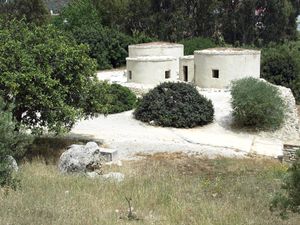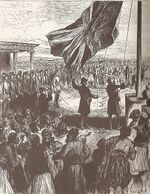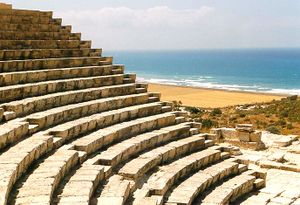تاريخ قبرص
جزء من سلسلة عن |
|---|
| تاريخ قبرص |
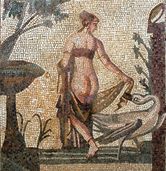 |
تاريخ قبرص.
العصور القديمة
 مقالات مفصلة: قبرص ما قبل التاريخ
مقالات مفصلة: قبرص ما قبل التاريخ- تاريخ قبرص القديم

يرجع تاريخ الشعوب القديمة التي سكنت الجزيرة إلى حوالي عام 6000 ق.م. واستوطن فيها اليونانيون عام 1200 ق.م وأنشأوا فيها الدّول ـ المدن التي كانت شبيهة بالدول ـ المدن اليونانية القديمة.
العصر البرونزي


The practice of writing spread and tablets in the Cypriot syllabic script have been found at Ras Shamra which was the Phoenician city of Ugarit. Ugaritic texts from Ras Shamra and Enkomi mention Ya, the Assyrian name of Cyprus, that thus seems to have been in use already in the late Bronze Age.
الخزف
الممالك-المدن القبرصية
 مقالة مفصلة: المدن الممالك العشر في قبرص
مقالة مفصلة: المدن الممالك العشر في قبرص
Most authors claim that the Cypriot city kingdoms, first described in written sources in the 8th century BC were already founded in the 11th century BC. Other scholars see a slow process of increasing social complexity between the 12th and the 8th centuries, based on a network of chiefdoms. In the 8th century (geometric period) the number of settlements increases sharply and monumental tombs, like the 'Royal' tombs of Salamis appear for the first time. This could be a better indication for the appearance of the Cypriot kingdoms.
العصر الحديدي المبكر
The early Iron Age on Cyprus follows the Submycenaean period (1125–1050 BC) of the Late Bronze Age. It is divided into the Geometric (1050–700), and Archaic (700–525) periods.
الفينيقيون
In the 8th century, several Phoenician colonies were founded, like Kart-Hadasht[بحاجة لمصدر] ('New Town'), present day Larnaca and Salamis. The oldest cemetery of Salamis has indeed produced children's burials in Canaanite jars, clear indication of Phoenician presence already in the LCIIIB 11th century. Similar jar burials have been found in cemeteries in Kourion-Kaloriziki and Palaepaphos-Skales near Kouklia. In Skales, many Levantine imports and Cypriote imitations of Levantine forms have been found and point to a Phoenician expansion even before the end of the 11th century.
قبرص القديمة

The first written source shows Cyprus under Assyrian rule. A stela found 1845 in Kition commemorates the victory of king Sargon II (721–705 BC) in 709 over the seven kings in the land of Ia', in the district of Iadnana or Atnana. The former is supposedly the Assyrian name of the island, while some authors take the latter to mean Greece (the Islands of the Danaoi). There are other inscriptions referring to Ia' in Sargon's palace at Khorsabad. The ten kingdoms listed by an inscription of Esarhaddon in 673/2 BC have been identified as Salamis, Kition, Amathus, Kourion, Paphos and Soli on the coast and Tamassos, Ledra, Idalium and Chytri in the interior.
Cyprus gained independence for some time around 669 but was conquered by Egypt under Amasis (570–526/525). The island was conquered by the Persians around 545 BC. A Persian palace has been excavated in the territory of Marion on the North coast near Soli. The inhabitants took part in the Ionian rising. At the beginning of the 4th century BC, Euagoras I, King of Salamis, took control of the whole island and tried to gain independence from Persia. Another uprising took place in 350 but was crushed by Artaxerxes in 344.
قبرص البيزنطية
 مقالات مفصلة: قبرص في العصور الوسطى
مقالات مفصلة: قبرص في العصور الوسطى - مملكة قبرص
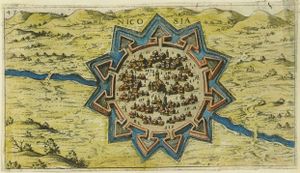

وقبل المسيح ـ عليه السلام ـ غزا قبرص كل من الآشوريين والمصريين واليونانيين والفرس والرومان. وكانت ضمن السيادة المصرية فترات خصوصا بعد تقسيم الامبراطورية الرومانية لشرقية وغربية. وأدخل القديس بولس والقديس برنابا النصرانية إلى الجزيرة عام 45م. وفي عام 330م صارت قبرص جزءًا من الإمبراطورية البيزنطية. فتح المسلمين قبرص في عهد الخليفة الراشد الثالث عثمان بن عفان 28 هـ \ 649م - 32 هـ \ 653م. وفي عام 1191م استولى ريتشارد قلب الأسد ـ ملك إنگلترة ـ على قبرص لكنه باعها لأحد النبلاء الفرنسيين. ثم احتلها مماليك مصر سنة 1426 م في عهد الأشرف سيف الدين برسباي. وخضعت هي وكريت والمورة وجزر يونانية-تركية اخري للسيادة المصرية العلوية.
الدولة العثمانية
 مقالة مفصلة: قبرص العثمانية
مقالة مفصلة: قبرص العثمانية
فتح الأتراك العثمانيون الجزيرة في سبعينيات القرن السادس عشر الميلادي، وحكموها حتى عام 1878 عندما سلًَّموها إلى بريطانيا التي حولت الجزيرة إلى مستعمرة ملكية عام 1925.
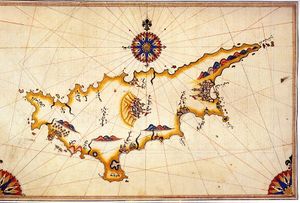
الإمبراطورية البريطانية
 مقالة مفصلة: تاريخ قبرص الحديث
مقالة مفصلة: تاريخ قبرص الحديث
In 1878, as the result of the Cyprus Convention, the United Kingdom took over the government of Cyprus as a protectorate from the Ottoman Empire. In 1914, at the beginning of World War I, Cyprus was annexed by the United Kingdom. In 1925, following the dissolution of the Ottoman Empire, Cyprus was made a Crown Colony. Between 1955 and 1959 EOKA was created by Greek Cypriots and led by George Grivas to perform enosis (union of the island with Greece). However the EOKA campaign did not result in union with Greece but rather an independent republic, The Republic of Cyprus, in 1960.
الإستقلال

في الخمسينيات من القرن العشرين الميلادي قام القبارصة اليونانيون بقيادة الأسقف مكاريوس بحملة سياسية للاتحاد مع اليونان ضمن تقليعة
حركة الهلينة المدعومة من أوروبا المسيحية، وكونوا منظمة سرية عرفت اختصارًا باسم أيوكا، شنت حرب عصابات عنيفة ضد البريطانيين. وأعلنت بريطانيا حالة الطوارئ في الجزيرة عام 1955. وفي عام 1956 نفت بريطانيا مكاريوس إلى جزيرة سيشل في المحيط الهندي. واجتمع الأتراك واليونانيون في زيوريخ بسويسرا عام 1959، حيث توصلوا لاتفاق يقضي بأن تصبح قبرص دولة مستقلة. وافقت بريطانيا على اتفاقية زيوريخ ونالت قبرص استقلالها في 16 أغسطس عام 1960 بمقتضى دستور وضعته كل من بريطانيا واليونان وتركيا بموافقة قادة القبارصة الأتراك واليونانيين. ووقعّت كل من بريطانيا واليونان وتركيا اتفاقية تكفل لقبرص استقلالها. واحتفظت بريطانيا بالسيطرة على قاعدتين عسكريتين في كل من أكروتيري وذكيليا على امتداد مناطق الساحل الجنوبي.
أصبح الأسقف مكاريوس رئيسًا للدولة الجديدة، واقترح في عام 1963م ثلاثة عشر تعديلاً للدستور، بدعوى أن ذلك سوف يؤدي إلى إدارة أفضل للبلاد. وقال إن بعض مواد الدستور تهدد أداء الحكومة بالشلل. عارض كل من الأتراك وقادة القبارصة الأتراك التعديلات الدستورية اعتقادًا منهم أنها ستؤدي إلى سلب القبارصة الأتراك حقوقهم وضماناتهم الدستورية. واندلع القتال بين القبارصة اليونانيين والقبارصة الأتراك. وفي عام 1964 أرسلت الأمم المتحدة قوات لحفظ السلام إلى قبرص بينما كانت الجهود مستمرة لحل المشكلة.
وفي عام 1967 نشب صراع آخر بين المجموعتين مما أدى إلى نشوب أزمة جديدة. وفي الفترة من عام 1967 إلى عام 1974 عقد القبارصة الأتراك، والقبارصة اليونانيون محادثات بهدف الوصول إلى اتفاق حول الدستور، وحدث بعض التقدم بيد أن الخلافات ظلت قائمة.
أُعيد انتخاب مكاريوس رئيسًا للجمهورية عام 1968 وعام 1973. وفي شهر يوليو عام 1974 أطاحت قوات الحرس الوطني بقيادة الضباط اليونانيين بالرئيس مكاريوس الذي فرّ على إثر ذلك من قبرص وخلفه في الرئاسة الناشر الصحفي نيكوس سامسون، ولكنه استقال بعد أسبوع واحد، وتولّى مهامّ الرئاسة بعده گلاڤكوس كلريدس رئيس مجلس النواب القبرصي.
وعقب الإطاحة بمكاريوس، قامت تركيا بغزو قبرص. واندلع قتال واسع النطاق بين الأتراك والقبارصة اليونانيين. واستولى الأتراك على أجزاء واسعة في شمال شرقي قبرص وفرَّ آلاف اليونانيين القبارصة إلى جنوب غربي قبرص.
وأدّت مفاوضات وقف إطلاق النار إلى وقف القتال في أغسطس، وعاد مكاريوس إلى قبرص رئيسًا للدولة في أواخر عام 1974، وتوفي عام 1977 وخلفه سپيروس كپريانو رئيس مجلس النواب القبرصي. إلا أن تركيا والقبارصة الأتراك رفضوا الاعتراف بحكومة سبايروس.
وظل ممثلو القبارصة الأتراك والقبارصة اليونانيين وممثلو اليونان والأتراك يجتمعون وينفضون منذ عام 1974 بغية التوصل إلى ترتيبات دستورية جديدة لكل جزيرة قبرص. إلا أن الخلافات الشديدة حول إدارة البلاد مازالت قائمة. وفي عام 1975 أعلن القبارصة الأتراك بقيادة رؤوف دنكتاش وغيره من الأتراك أن المناطق الشمالية من قبرص مناطق تتمتع بالحكم الذاتي، وسموها الولايات القبرصية التركية الفيدرالية، وفي عام 1983 أعلن القبارصة الأتراك هذه المناطق جمهورية مستقلة سموها جمهورية شمالي قبرص التركية. وعلى أي حال فإن الأمم المتحدة، وكل دول العالم ماعدا تركيا تعترف بقبرص دولة واحدة بقيادة الحكومة القبرصية اليونانية في الجنوب الغربي.
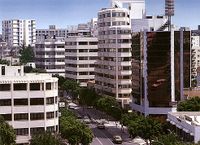
الحقبة المعاصرة
انظر أيضاً
عام:
الهامش
للاستزادة
- History, general
- Paul W Wallace & Andreas G Orphanides (eds.), "Sources for the History of Cyprus", vols I - XV, (Albany, NY, Greece and Cyprus Research Center, University at Albany (SUNY) 1990-2007)
- C. D. Cobham, Excerpta Cypria: materials for a history of Cyprus (Cambridge 1908). Nice Collection of written sources.
- D. Hunt, Footprints in Cyprus (London, Trigraph 1990).
- Prehistory
- Vassos Karageorghis, Cyprus (1969). Includes bibliography.
- Andreas G Orphanides, "Late Bronze Age Socio-Economic and Political Organization, and the Hellenization of Cyprus", Athens Journal of History, volume 3, number 1, 2017, pp. 7–20 [1]
- Veronica Tatton-Brown, Cyprus BC: 7000 years of history (London, British Museum 1979).
- Stuart Swiny, Earliest Prehistory of Cyprus (American School of Oriental Research 2001) ISBN 0-89757-051-0
- J. M. Webb/D. Frankel, "Characterising the Philia facies. Material culture, chronology and the origins of the Bronze Age in Cyprus" in American Journal of archaeology 103, 1999, 3-43.
- S. Gitin/A. Mazar/E. Stern (eds.), Mediterranean peoples in transition, thirteenth to early 10th century BC (Jerusalem, Israel exploration Society 1998). Late Bronze Age and transition to the Iron Age.
- J. D. Muhly, "The role of the Sea People in Cyprus during the LCIII period. In: Vassos Karageorghis and J. D. Muhly (eds.), Cyprus at the close of the Bronze Age (Nicosia 1984), 39-55. End of Bronze Age
- Classical Period, Sources
- Paul W Wallace & Andreas G Orphanides (eds.), "Sources for the History of Cyprus: Greek and Latin Texts to the Third Century A.D.", vol. I, (Nicosia, The Institute of Cypriot Studies, University at Albany (SUNY) & Cyprus College 1990)[2]
- Herodotus, "The Histories"
- Isocrates, "Nicocles"
- Diodorus Siculus, "Bibliothiki" (Library)
- Arrian, "The Campaigns of Alexander the Great"
- T. Bekker-Nielsen, The Roads of Ancient Cyprus. Copenhagen: Museum Tusculanum 2004. * [1]
- Mediaeval Age
- Angel Nicolaou-Konnari, Chris Schabel (eds.): Cyprus: Society and Culture, 1191–1374); Leiden : Brill, 2005. - XVI, 403 S., ISBN 90-04-14767-5
- Peter W. Edbury: The Kingdom of Cyprus and the Crusades, 1191–1374 (Cambridge, 1991).
- History, 20th century
- C. Spyridiakis, The education policy of the English government in Cyprus (1878–1954).
- C. Spyridiakis, A brief history of Cyprus.
- Mythology
- Bibliotheca
- Pausanias, "Description of Greece"
- Ovid, "Metamorphosis"
وصلات خارجية
- "Cyprus, as I Saw it in 1879" by Samuel W. Baker.
- Cyprus - an island divided - Interactive guide from The Guardian
- ^ <https://www.academia.edu/30822917/Andreas_G._Orphanides_Late_Bronze_Age_Socio-Economic_and_Political_Organization_and_the_Hellenization_of_Cyprus_Athens_Journal_of_History_volume_3_number_1_2017_pp._7-20>
- ^ <https://www.academia.edu/10335676/Paul_W._Wallace_and_Andreas_G._Orphanides_Sources_for_the_History_of_Cyprus_Greek_and_Latin_Texts_to_the_Third_Century_A.D._Volume_I>
